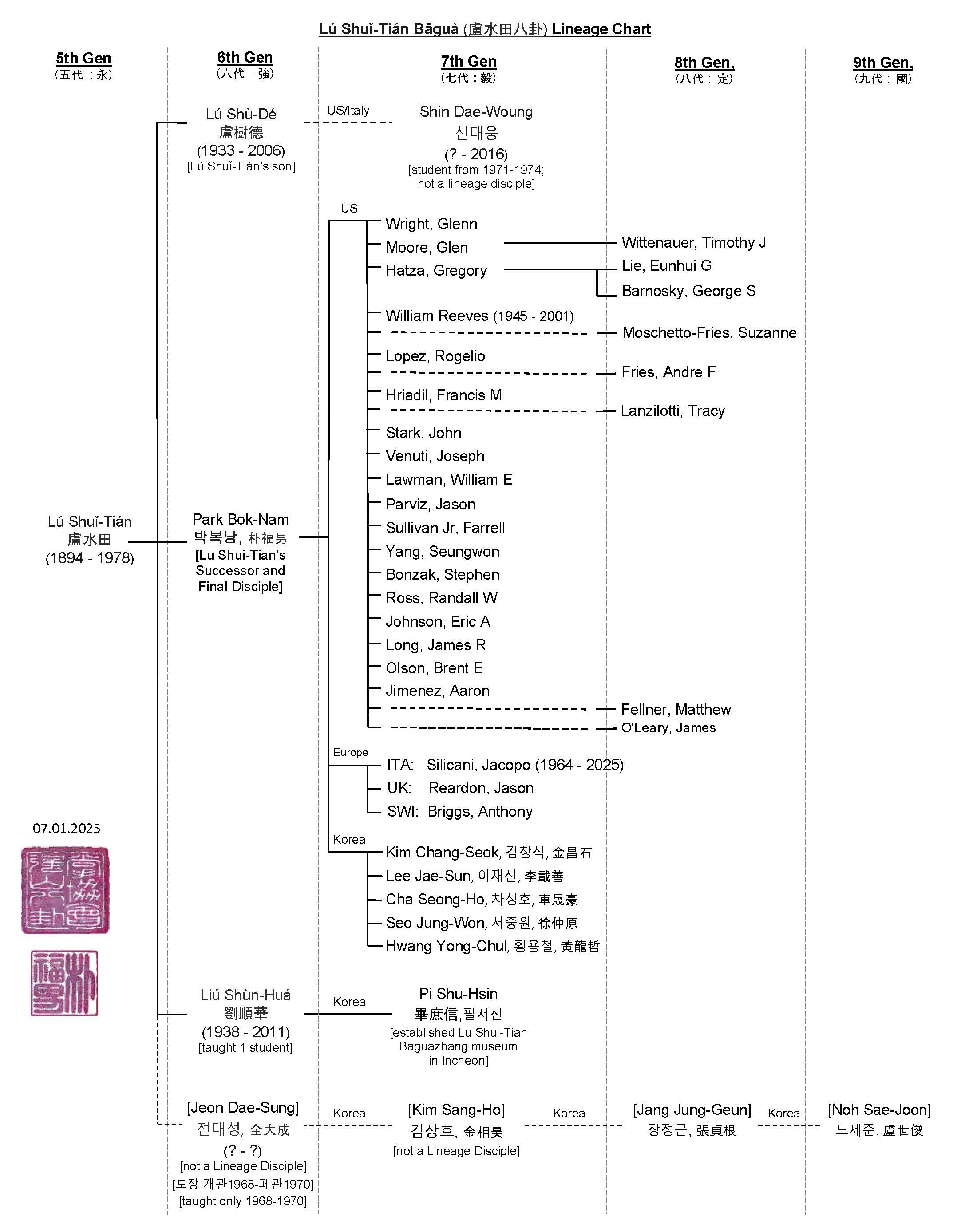 |
 |
 |
 |
 |
 |
 |
Park Bok-Nam studied the
art of Pa Kua Chang (Baguazhang) for 15 years under his
mentor Lu Shui-Tian. Park started training with Lu in
1963, when he was 21 years old. From 1963 to 1978,
the only thing that Park did was study and practice Pa Kua
/ Bagua.
Park trained with Lu Shui-Tian in Incheon, Korea. Lu had brought Pa Kua / Bagua to Korea when he moved his family there during the Sino-Japanese War. Born in 1894, Lu Shui-Tian was from the city of Ching Tao in Shantung Province, China, and was well-known for his high level of martial arts ability. Though still very strong and healthy, Lu died tragically and accidentally in 1978, at the age of 83, when he was overcome in his sleep by a malfunctioning gas heater. |
| Park Bok-Nam excelled under the rigorous training
regimen imposed by his teacher, and was ultimately chosen
by Lu Shui-Tian to be his successor and Final Disciple,
and was recognized as such by Lu Shui-Tian's son, Lu
Shu-De, and daughter,
Lu Shu-Qin. Through his experiences as a student under
Lu's watchful eye, Park developed a very sound and
thorough Pa Kua Chang / Baguazhang training program. Park
began teaching Pa Kua / Bagua in Korea in 1970. He
continued in the tradition of Lu Shui-Tian and became
widely-acknowledged for his high level of skill as a Pa
Kua / Bagua practitioner and instructor. |
| As a testament to his authenticity, Park Bok-Nam's name appears on a stele that was erected at the burial site of Dong Hai-Chuan* in China (see picture at right), formally documenting him as a true sixth generation lineage disciple. The stele was sponsored by the Korean Kung Fu Association in 1991 to officially record the lineage history of Pa Kua Chang / Baguazhang in Korea. |
 |
- Lu Shui-Tian - Park Bok-Nam |
In the years from 1979 to 1986, Park took many students to fighting tournaments in Hong Kong and Taiwan. His teams always performed very well in these full contact events and were always very much anticipated by the crowds in attendance. In 1987, Park moved to the United States and opened a school in Richmond, VA -- where he has established his headquarters. |
Park Bok-Nam has developed one of the most comprehensive
training programs in existence today for learning Pa Kua
Chang (Ba Gua Zhang). He is a true specialist in the art
of Pa Kua (Ba Gua) and has written numerous articles for
various martial arts publications. He has also authored a
two volume set of manuals and videos entitled The Fundamentals of Pa Kua Chang
(see Reference
Information). Two Italian editions are
now on sale throughout Europe.
|
| The May 1999 issue of Martial Arts Legends Presents - CHI POWER featured a rare interview by Master Park, entitled "Lu Shui-Tian's Ba Gua Zhang - An Interview with Master Park Bok-Nam," in which he discussed what is important in studying Pa Kua (Bagua, Ba Gua), how he came to study Pa Kua (Bagua, Ba Gua), his approach to teaching Pa Kua (Bagua, Ba Gua) as a martial art, and his hopes for the future of his art. An excerpt from this article was provided in the December 2000, Edition #13 back issue of the FYIPage. It is archived on the Reference Information page of this website. |
 |
He is one of a select number of recognized martial
artists in = = = |
| With over 55 years of experience, Park
Bok-Nam is one of the most skilled Pa Kua (Bagua, Ba Gua)
practitioners and instructors alive today. He offers
regular classes, seminars, and training camps throughout
America and Europe. |
| People have inquired about the background of Lu
Shui-Tian. Park Bok-Nam asked Lu Shui-Tian
about his Pakua / Bagua lineage, and Lu Shui-Tian told him
that Baguazhang existed before Dong Hai-Chuan. Lu
Shui-Tian said that he learned Pakua / Bagua primarily
from Li Qing-Wu, who was from a secret Baguazhang
lineage separate from Dong Hai-Chuan. After Li
Qing-Wu passed away, Lu Shui-Tian met Yin Fu and Wang Dou
lineage practitioners, and learned some of Dong
Hai-Chuan's method from them. However, because he
learned primarily from Li Qing-Wu, Lu Shui-Tian chose to
trace his lineage from Li Qing-Wu and not Dong
Hai-Chuan. The origin history that he described
to Park Bok-Nam is provided below. Lu
Shui-Tian passed away before he had the chance to provide
Park Bok-Nam with anymore detail than this. |

| Over his many years of teaching Pa Kua /
Bagua, Park Bok-Nam has formally accepted a number of
individuals from the U.S, Europe, and Korea into his Pa
Kua / Bagua lineage, the lineage of Lu Shui-Tian.
These 7th and 8th Generation Lineage Disciples are shown
in the official Lu Shui-Tian lineage chart,
established by Park Bok-Nam, which is provided
below. |

| A number of individuals in Korea are
shown on this chart. Lu Shu-De was the son of Lu
Shui-Tian. Shin Dae-Woung studied a few years
with Lu Shu-De. Liu Shin-Hua taught 1 student,
Pu Shu-Hsin, Pu Shu-Hsin has established a
museum in Incheon on the life and history of Lu
Shui-Tian and his Pa Kua Chang (Baguazhang, Ba Gua
Zhang). Jeon Dae-Sung left Lu Shui-Tian and
taught for only a short time (less than 3
years). During this brief period, he taught Kim
Sang-Ho. Kim Sang-Ho subsequently taught Jang
Jung-Geun, and Jang Jung-Geun subsequently taught Noh
Sae-Joon. |
| * NOTE: | Dong Hai-Chuan (1813 - 1882) is recognized by many, but not all, Pa Kua / Bagua practitioners and historians as the originator of Pa Kua / Bagua. At a minimum, Dong was the first practitioner to openly promote Pa Kua / Bagua. |
 |
 |
 |